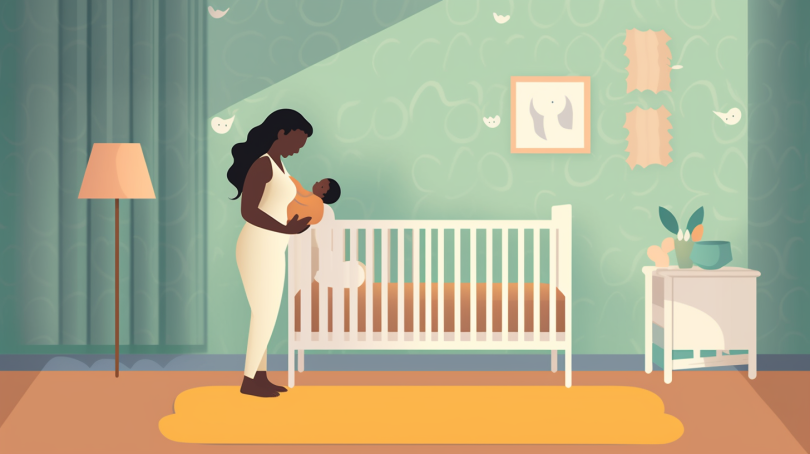As a parent or caregiver of a newborn, there are countless concerns and questions that arise, especially when it comes to ensuring their safety and well-being. One critical aspect of caring for a newborn is understanding the importance of proper sleep positioning. In this blog post, we will discuss the risks associated with newborns sleeping on their stomachs and provide safety precautions and guidelines to help you make informed decisions about your baby’s sleep habits.
The Dangers of Stomach Sleeping for Newborns
While it may seem harmless, allowing your newborn to sleep on their stomach (also known as the prone position) can pose significant risks to their health and safety. The primary concern regarding stomach sleeping is its strong association with Sudden Infant Death Syndrome (SIDS), which is the unexplained death of a seemingly healthy baby less than one year old. Although the exact cause of SIDS is still unknown, research has shown that infants who sleep in the prone position are at a higher risk.
There are several reasons why stomach sleeping can increase the risk of SIDS. One potential explanation is that babies who sleep on their stomachs are more likely to rebreathe exhaled carbon dioxide, leading to increased levels of carbon dioxide in their blood and reduced oxygen supply. Additionally, infants who sleep in this position may be more susceptible to overheating or suffocation due to inadequate airflow around their face.
Pediatrician Recommendations: The “Back to Sleep” Campaign
In response to the concerning link between prone sleeping and SIDS, pediatricians have strongly recommended placing infants on their back for every sleep since 1994 when the American Academy of Pediatrics (AAP) launched its “Back to Sleep” campaign (now called “Safe to Sleep”). This initiative has led to a significant decrease in SIDS rates by promoting safe sleep practices, including placing babies on their back to sleep.
According to the AAP, the safest sleeping position for infants is on their back until they reach their first birthday. This recommendation applies to both nighttime sleep and naps. Once your baby can roll over independently, it’s generally considered safe for them to adopt different sleeping positions. However, it’s crucial to consult with your pediatrician about your baby’s specific needs and developmental milestones.
Creating a Safe Sleep Environment
Beyond adopting the recommended back sleeping position, there are additional steps you can take to create a safe sleep environment for your newborn. Here are some essential guidelines:
- Use a firm sleep surface: Ensure that your baby sleeps on a firm mattress with a fitted sheet designed for that specific product. Avoid using soft bedding, pillows, or blankets in the crib as they can pose suffocation risks.
- Keep the sleep area clutter-free: Remove any toys, stuffed animals, or loose bedding from your baby’s sleep area to minimize the risk of suffocation or entrapment.
- Avoid overheating: Dress your baby in light clothing and maintain a comfortable room temperature (recommended between 68°F and 72°F). Overheating can increase the risk of SIDS.
- Consider room-sharing: The AAP recommends room-sharing without bed-sharing for at least the first six months of life as it has been shown to decrease SIDS rates by up to 50%.
Tips for Encouraging Back Sleeping
If you’re struggling with getting your newborn used to sleeping on their back, here are some helpful tips:
- Establish a consistent sleep routine: Consistency is key when it comes to developing healthy sleep habits. Implementing a regular bedtime routine can help signal to your baby that it’s time for sleep and encourage the adoption of the back sleeping position.
- Swaddle your baby: Swaddling can provide comfort and security to your newborn, making it easier for them to adjust to sleeping on their back. Ensure that you follow safe swaddling guidelines and stop swaddling once your baby shows signs of attempting to roll over.
- Use a pacifier: Offering a pacifier during naps and nighttime sleep has been shown to reduce the risk of SIDS. Be sure to wait until breastfeeding is well-established before introducing a pacifier, typically around three to four weeks of age.
- Consult with your pediatrician: If you continue to experience difficulties with back sleeping or have concerns about your baby’s sleep habits, consult with your pediatrician for personalized guidance and support.
Conclusion
The safety and well-being of our newborns are of paramount importance, and understanding the risks associated with stomach sleeping is crucial in making informed decisions about their care. By following expert guidelines and creating a safe sleep environment, we can significantly reduce the risk of SIDS and promote healthy sleep habits for our little ones. Remember always to consult with your pediatrician if you have any concerns or questions about your newborn’s sleeping patterns or behaviors.

